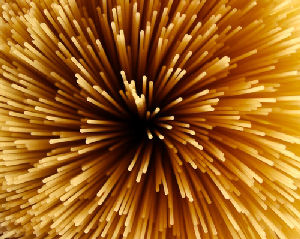Angel Hair
 |
The fine strands of angel hair pasta should accompany equally delicate foods and sauces. |
Angel hair pasta is the thinnest of the spaghetti strands, or rods. It is favored for pairing with the lightest sauces or for inclusion in broths and soups. Cooking perfect angel hair is a bit tricky if you are accustomed to heavier pastas. In Italian, the name is capelli d’angelo.
Varieties
The most common type is “plain.” The straw color is from durum semolina wheat. Some products are made with added tomato paste (reddish) or spinach (green). Angel hair is sometimes packaged in “nests.” These can be dropped directly into boiling water or into hot oil and fried.
You may hear the word “cappellini,” referred to as angel hair. This pasta, however, is slightly thicker.
Hand-milled and organic pastas are also available.
Buying Tips
Handle boxes or bags with care and keep them protected from heavy objects in a shopping cart. Gently tip the package from end to end; avoid those with too many broken strands.
Storage Tips
As with all pastas, angel hair lasts indefinitely in a cool, dry spot. Most manufacturers recommend approximately eighteen months.
Usage Tips
The most important part of cooking thin pastas is attention to the short cooking time. Angel hair requires only two to four minutes in boiling water.
When adding to a broth, break the strands into thirds.
Substitutions:
Capellini and vermicelli are marginally thicker than angel hair and will work well. Adjust cooking times accordingly.
Try one of our favorite angel hair recipes:
Broccoli and Angel Hair Pasta
Baked Angel Hair and Shrimp
Angel Hair Frittata
Suggested Pairings
Asparagus, mushrooms, olive oil, prosciutto, scallops, shrimp





